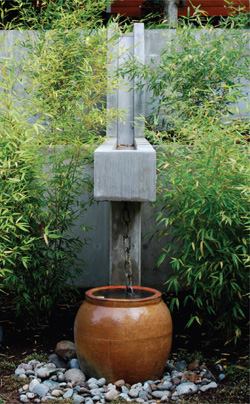Designer: Samuel H. Williamson Associates, Portland, Ore.; Landscape contractor: Gardens by Michael Angelo, Seattle.
If a garden is a reduced version of nature, manmade water elements also mimic what occurs naturally: a waterfall, a bubbling stream, a deep pool. A runnel’s strong geometry is a little more abstract, though, making it well-suited to minimalist gardens like those designed by Portland, Ore., landscape architect Sam Williamson. “I like the artificiality of runnels—that long, thin proportion and the hint of water in the landscape. It’s a subtle element rather than a big, brash thing you see in the garden,” says Williamson, who heads up Samuel H. Williamson Associates and has included runnels in at least three client projects.
To understand his approach to these narrow canals, you have to understand his philosophy of garden-making. “I like that tension between something that’s trying to be natural but doesn’t feel natural,” he says.
Unlike some water features, runnels leave no doubt that they’re manmade. In fact, they originated in the early Islamic gardens of central Asia. Rain was scarce, but melting snow from distant mountains provided a year-round water supply, and the Persians used open channels to bring water to towns and farming villages. The resulting irrigation system—large channels with smaller ones leading off at right angles—inspired the design of Persia’s public gardens.
Williamson was playing with that concept when he designed a courtyard garden for a house on the Charles River in Dover, Mass. He placed a serpentine runnel on the centerline of an axial terrace that sweeps out from the house to a large lawn and the woods beyond. The water starts in an 18-inch basin directly outside a trio of French doors. It drops over a lip to the foot-deep runnel, which winds among birches, irises, and small aquatic plants before spilling into a lower pool at the edge of the terrace.



